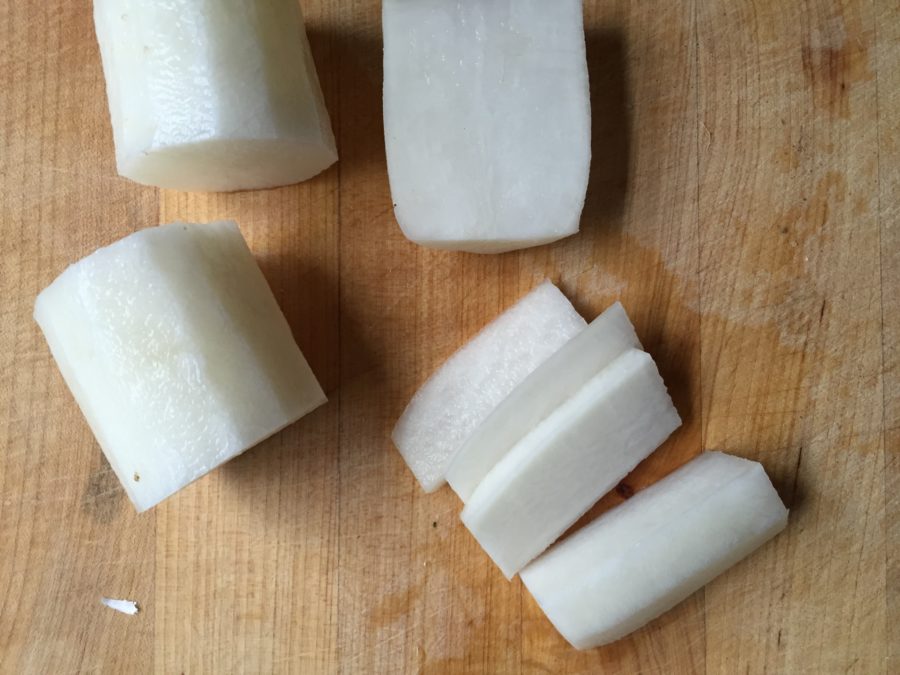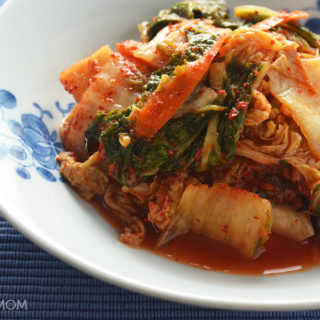Easy to Make Cabbage Kimchi (Mak Kimchi) #SundaySupper
Servings: 1 gallon
Ingredients
- 8 pounds Napa cabbage
- 3/4 cup coarse sea salt or Kosher salt
- 15-18 cloves of garlic roughly chopped
- 1 1/2 " knob of ginger peeled and roughly chopped
- 1 cup gochukaru Korean red pepper flakes
- 1/3 cup fish sauce
- 1/8-1/4 cup white granulated sugar
- 5-6 stalks of green onions thinly sliced
- 8 ounces daikon or Korean radish julienned
- 2-3 carrots julienned
Instructions
- Brining the cabbage: Discard any wilted or discolored leaves. Starting at the base of the stem, cut the cabbage about one-third of the way down. Then pull apart the cabbage halves to completely separate them. Do the same with the halved portions - cut and pull apart. Repeat for all the cabbage heads.
- Trim the core at the base at a diagonal. Cut the quarters into 2-inch wide pieces and place in an colander. Rinse and drain. Work in batches if necessary.
- Transfer a couple of handfuls of cabbage to an oversized bowl. If you don't have one of those giant bowls from HMart, use a couple of large bowls. Sprinkle generously with some salt. Alternate layers of cabbage and salt. Once the bowls are full, top with a sprinkle of salt. If using one big bowl, add about a 2 cups of water. Cover each mound of cabbage with a plate. One that is smaller that the mouth of the bowl so that the plate rests on the cabbage.
- Let the salted cabbage sit on the counter for 8-12 hours. Give it a toss every now and then.
- Preparing the sauce: While the cabbage is close to being ready, prepare the red pepper sauce. In a blender, add the garlic, ginger, and about 1/2 cup of water. Pulse until pureed.
- In a large bowl, mix kochukaru (red pepper flakes), the ginger/garlic paste, fish sauce, green onions, and sugar. The mixture should have the consistency of a thick batter. If it's a little thick add about a 1/2 cup of water, a 1/4 at a time. Taste. It should be balanced – not too salty, not too fishy, not to spicy and not too sweet. Adjust seasonings at this point.
- Slice the daikon in 2-inch sections as shown below. Cut the radish crosswise in 2-inch sections. Cut those sections in half and slice into 1/8" thick slices.

- Mix in carrots and radish into the red pepper mixture.
- Make the kimchi: Once the cabbage is ready (the volume of the cabbage should have decreased, and it should be a bit wilted), drain in a colander and give it a quick rinse.
- At this point you may want to wear clean food-safe plastic gloves especially if you have sensitive skin. Transfer the cabbage to the bowl with the sauce. Mix after adding a few handfuls. Thoroughly mix the sauce and cabbage and make sure every piece of cabbage is coated with the red pepper sauce. Taste. Always taste.
- Transfer the cabbage mixture into a large glass jar. Press down on the cabbage as you are filling the jar. Leave about 1-inch of space from the top.
- Don’t throw the empty bowl in the sink just yet. Pour enough water (about 1/2 cup) into the bowl to get all the pepper sauce. Carefully pour into the jar. Close the lid, but not too tightly. You want some air to escape as the kimchi ferments.
- Leave the jar at room temperature** for about a day on the counter away from direct sunlight. I leave mine out for about 24-30 hours. This is when the magic happens. You may want to place the jar in a shallow bowl or plate in case there is overflow of kimchi juice.
- After those 24 or so excruciating hours, sample the kimchi. There should be a slight tang. At this point it is ready to be refrigerated. A good indicator is if you start to see bubbles at the surface. You can eat the kimchi right away or if you're like me, I like to wait a week or so. The kimchi will continue to ferment at a much slower pace in the refrigerator and will keep for about 4 weeks. At about the 3-4 week mark the kimchi will turn really sour at this point and if you have any left in the jar, it will be perfect for jigae, fried rice, ramen or jun.
Notes
**What is “room temperature”? Wikipedia says it’s the temperature indicated by general human comfort, about 68°F to 77°F.
